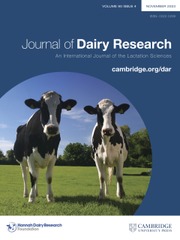The Journal of Dairy Research is an international journal, approaching its one-hundredth anniversary. The first issue of the first volume was published in print in November 1929, and then online 80 years later. It was set up by the then National Institute for Research in Dairying (Reading, UK) and Hannah Dairy Research Institute (Ayr, also UK). The foreword to that first issue was written by Lord Passfield, of the Dominions Office (Passfield, 1929), and reveals that the Journal was established with the financial support of the Empire Marketing Board (EMB). It had the aim of assisting “dairy research workers in every part of the Empire” and had a very clearly prescribed format: “Each issue will include a monograph by a leading authority on some broad question of dairy research work, and, when space permits, a second authoritative monograph on some subject of immediate practical importance to the dairy industry. Detailed papers of scientific interest compiled by research workers will follow; and the issue will be completed by reviews and records of current scientific contributions to dairy research drawn from all parts of the world”. Lord Passfield's foreword emphasises the need for research in tropical dairy farming: “The provision of a sufficient milk supply for the inhabitants of the tropics is a problem of the greatest importance to many parts of the Empire and a problem not yet solved. Upon the dairy research workers of the Empire rests a great opportunity for the betterment of the health of its peoples”.
Arising from the Imperial Economic Committee, itself formed in 1923 or shortly after, the Empire Marketing Board (EMB) was at least partially a response to increasing protectionism by America and misperceptions of competitive performance in the Soviet Union (Elliot, Reference Elliot1931). The first post-war American measures were the Emergency Tariff Act of 1921 and the Fordney-McCumber Tariff Act of 1922, the ineffectiveness of which (from an American dairy farmer's perspective) is pithily described by Gersting (Reference Gersting1929). The EMB was established to “further the marketing of Empire produce in the United Kingdom” (Elliot, Reference Elliot1931), and as an economic measure it is considered to have been as unsuccessful as the tariffs that prompted its formation (Higgins and Varian, Reference Higgins and Varian2021).
The founding of the Journal of Dairy Research could therefore be said to have been a British colonial response to punitive tariffs imposed by America. Although this is not the purest origin story that one could wish for, the aims of providing a scientific resource for dairy researchers and dairy producers around the world are alive and well. Despite the economic ineffectiveness of the EMB, the Journal has continued with a similar scientific mission, and a broadly similar range of content as outlined in its first issue. It has continued to service an international research community, largely based in or with a focus on dairying in the tropics and subtropics. The Editorial Board includes members living and working in 19 countries but representing even more countries of origin. Over the last calendar year, 99 manuscripts have been accepted, from 31 countries, with Brazilian-based manuscripts accounting for more than any other nationality (18 manuscripts).
The Hannah Dairy Research Foundation is now the owner of the Journal, and its mission has not changed much from that set out in 1929. It “…supports all aspects of dairy research including the biology, wellbeing of dairy animals, dairy technology and food production. The Foundation's aim is to stimulate original scientific research, encourage and inspire young scientists in the field, invigorate industry and enable dairy farmers through advances in knowledge, technology and good practice”. The Journal continues to publish basic and applied research across the whole spectrum of dairy production, regardless of the technologies used, if it is well conceived, well conducted, well described, well analysed, well interpreted, and rigorous in all respects.
The colonial legacy of the Journal is acknowledged, and firmly relegated to the past, while the broader mission continues with a commitment to excellence in dairy research wherever livestock are kept for milk production.

